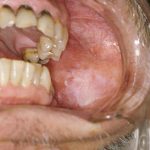 A nonspecific white patch in the oral cavity which will not rub off.
A nonspecific white patch in the oral cavity which will not rub off.
Condition characterized by white spots or patches on mucous membranes, especially of the mouth and vulva.
A white patch that may develop on mucous membranes such as the cheek, gums, or tongue and may become cancerous.
A precancerous condition in which white patches occur or form on mucous membranes, such as the tongue, cheek, or female genitalia.
Thickened, white patches on mucous membranes, especially those of the mouth region and genitalia; they can become malignant.
Raised white patches on the inside of the cheek, tongue, or lips. In the mouth, leukoplakia may be due to irritation from poorly fitted dentures, chronic cheek biting, or tobacco. In its early stages, leukoplakia usually causes no symptoms and is diagnosed during the course of a routine physical or dental examination. Because it is a potentially cancerous condition, leukoplakia must be closely monitored by a physician; a biopsy may be necessary. Treatment consists of eliminating all tobacco products and other irritants.
Thickened white patches on membranes, such as the mouth lining or vulva, due to an overgrowth of the tissues. Leukoplakia may be caused by excessive smoking or alcohol, syphilis, or other infections; it can become malignant.
A white plaque on mucous membranes caused by overgrowth of the tissues. It is occasionally a pre-cancerous condition.
Formation of white spots or patches on the mucous membrane of the tongue or cheek. The spots are smooth, irregular in size and shape, hard, and occasionally fissured. The lesions may become malignant.
Hard, white leathery patches or sores that form on the inside of the mouth and may develop into cancer; they are often the result of smokeless tobacco use.
A smooth, whitish patch on the oral mucosa that lacks a specific cause such as thrush or any other particular ailment.
Elevated white patches on the mucous membranes of the mouth or vulva caused by thickened tissue. This condition is predominantly observed in elderly individuals and those with AIDS.
White patches in the oral cavity, typically found on the tongue, are commonly known as leukoplakia. This condition is often linked to smoking or the friction caused by a rough tooth or denture. However, the exact factors leading to its occurrence on the vulva remain unknown.
While the elevated patches generally do not cause harm or pain, there are instances where they can undergo a cancerous transformation in the impacted tissue. Due to this potential risk, it is important to always consult a doctor when dealing with leukoplakia.
If the situation continues, the patches are taken out using either general or local anesthesia. Then, the tissue is examined under a microscope to look for any indications of malignancy.
A condition marked by the thickening and whitening of a mucous membrane’s surface, which may lead to hypertrophy and occasionally progress into cancerous transformations.
